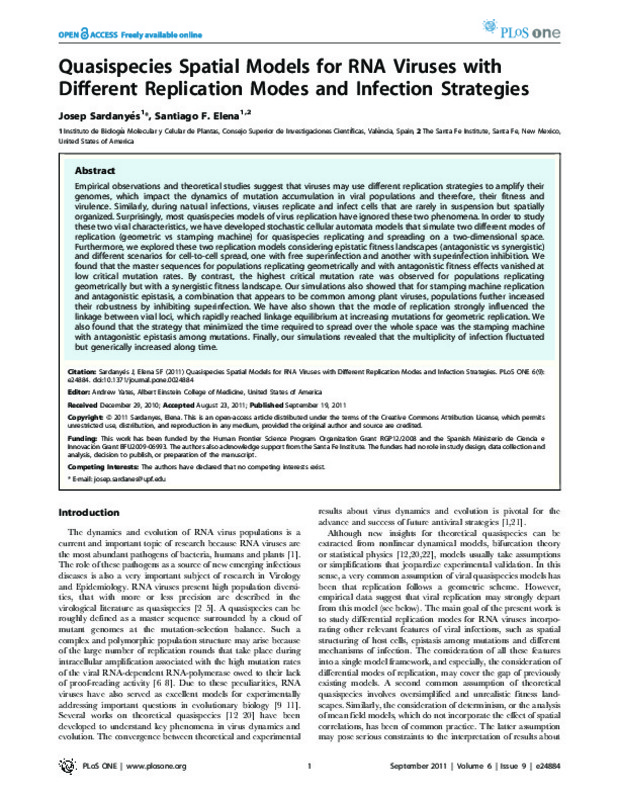JavaScript is disabled for your browser. Some features of this site may not work without it.
Buscar en RiuNet
Listar
Mi cuenta
Estadísticas
Ayuda RiuNet
Admin. UPV
Quasispecies spatial models for RNA viruses with different replication modes and infection strategies
Mostrar el registro sencillo del ítem
Ficheros en el ítem
| dc.contributor.author | Sardanyes Cayuela, Jose
|
es_ES |
| dc.contributor.author | Elena Fito, Santiago Fco
|
es_ES |
| dc.date.accessioned | 2013-05-06T11:33:03Z | |
| dc.date.available | 2013-05-06T11:33:03Z | |
| dc.date.issued | 2011 | |
| dc.identifier.issn | 1932-6203 | |
| dc.identifier.uri | http://hdl.handle.net/10251/28571 | |
| dc.description.abstract | [EN] Empirical observations and theoretical studies suggest that viruses may use different replication strategies to amplify their genomes, which impact the dynamics of mutation accumulation in viral populations and therefore, their fitness and virulence. Similarly, during natural infections, viruses replicate and infect cells that are rarely in suspension but spatially organized. Surprisingly, most quasispecies models of virus replication have ignored these two phenomena. In order to study these two viral characteristics, we have developed stochastic cellular automata models that simulate two different modes of replication (geometric vs stamping machine) for quasispecies replicating and spreading on a two-dimensional space. Furthermore, we explored these two replication models considering epistatic fitness landscapes (antagonistic vs synergistic) and different scenarios for cell-to-cell spread, one with free superinfection and another with superinfection inhibition. We found that the master sequences for populations replicating geometrically and with antagonistic fitness effects vanished at low critical mutation rates. By contrast, the highest critical mutation rate was observed for populations replicating geometrically but with a synergistic fitness landscape. Our simulations also showed that for stamping machine replication and antagonistic epistasis, a combination that appears to be common among plant viruses, populations further increased their robustness by inhibiting superinfection. We have also shown that the mode of replication strongly influenced the linkage between viral loci, which rapidly reached linkage equilibrium at increasing mutations for geometric replication. We also found that the strategy that minimized the time required to spread over the whole space was the stamping machine with antagonistic epistasis among mutations. Finally, our simulations revealed that the multiplicity of infection fluctuated but generically increased along time. | es_ES |
| dc.description.sponsorship | This work has been funded by the Human Frontier Science Program Organization Grant RGP12/2008 and the Spanish Ministerio de Ciencia e Innovacion Grant BFU2009-06993. The authors also acknowledge support from the Santa Fe Institute. The funders had no role in study design, data collection and analysis, decision to publish, or preparation of the manuscript. | |
| dc.language | Inglés | es_ES |
| dc.publisher | Public Library of Science | es_ES |
| dc.relation.ispartof | PLoS ONE | es_ES |
| dc.rights | Reconocimiento (by) | es_ES |
| dc.subject | Vesicular stomatitis-virus | es_ES |
| dc.subject | Eigen evolution model | es_ES |
| dc.subject | Streak mosaic-virus | es_ES |
| dc.subject | Superinfection exclusion | es_ES |
| dc.subject | Bacteriophage phi-6 | es_ES |
| dc.subject | Population | es_ES |
| dc.subject | Multiplicity | es_ES |
| dc.subject | Epistasis | es_ES |
| dc.subject | Selection | es_ES |
| dc.subject | Dynamics | es_ES |
| dc.title | Quasispecies spatial models for RNA viruses with different replication modes and infection strategies | es_ES |
| dc.type | Artículo | es_ES |
| dc.identifier.doi | 10.1371/journal.pone.0024884 | |
| dc.relation.projectID | info:eu-repo/grantAgreement/HFSP//RGP0012%2F2008/ | es_ES |
| dc.relation.projectID | info:eu-repo/grantAgreement/MICINN//BFU2009-06993/ES/Biologia Evolutiva Y De Sistemas De La Emergencia De Fitovirus De Rna/ | es_ES |
| dc.rights.accessRights | Abierto | es_ES |
| dc.contributor.affiliation | Universitat Politècnica de València. Instituto Universitario Mixto de Biología Molecular y Celular de Plantas - Institut Universitari Mixt de Biologia Molecular i Cel·lular de Plantes | es_ES |
| dc.description.bibliographicCitation | Sardanyes Cayuela, J.; Elena Fito, SF. (2011). Quasispecies spatial models for RNA viruses with different replication modes and infection strategies. PLoS ONE. 6:24884-24884. https://doi.org/10.1371/journal.pone.0024884 | es_ES |
| dc.description.accrualMethod | S | es_ES |
| dc.relation.publisherversion | http://dx.doi.org/10.1371/journal.pone.0024884 | es_ES |
| dc.description.upvformatpinicio | 24884 | es_ES |
| dc.description.upvformatpfin | 24884 | es_ES |
| dc.type.version | info:eu-repo/semantics/publishedVersion | es_ES |
| dc.description.volume | 6 | es_ES |
| dc.relation.senia | 218197 | |
| dc.identifier.pmid | 21949777 | |
| dc.identifier.pmcid | PMC3176287 | en_EN |
| dc.contributor.funder | Ministerio de Ciencia e Innovación | |
| dc.contributor.funder | Human Frontier Science Program Organization | |
| dc.contributor.funder | Santa Fe Institute | es_ES |








